- Home
-
SHOP ECO FARM
- ECO Farm Grow Lights
- ECO Farm LED Grow Lights
- ECO Farm Quantum Board
- ECO Farm Samsung LED Grow Lights
- ECO Farm COB Grow Lights
- ECO Farm Commercial Lights
- ECO Farm Supplemental Grow Light
- ECO Farm Fluorescent grow lights
- ECO Farm HPS & MH Grow Lights
- ECO Farm CMH Grow Lights
- ECO Farm HID/CMH Bulbs & Ballasts
- ECO Farm Grow Tents & Kits
- ECO Farm 2x2ft Grow Kits
- ECO Farm 3x3ft Grow Kits
- ECO Farm 3.3x3.3ft Grow Kits
- ECO Farm 4x4ft Grow Kits
- ECO Farm 5x5ft Grow Kits
- ECO Farm Grow Tent - Standard Style
- ECO Farm Grow Tent - Extension & Roof & Lodge Style
- ECO Farm Extraction & Harvest
- ECO Farm Rosin Press Machine
- ECO Farm Dry & Wet Trimmers
- ECO Farm Oil Accessories
- ECO Farm Medicinal Plants Grinder
- ECO Farm Medicinal Plants Containers
- ECO Farm Medicinal Plants Dryer
- ECO Farm Refrigeration Dryer
- ECO Farm Climate Control & Other Accessories
- ECO Farm Inline Duct Fans
- ECO Farm Oscillating Fans
- ECO Farm Exhaust Fans
- ECO Farm Air Filter
- ECO Farm Duct Muffler
- ECO Farm Ventilation Kits
- ECO Farm Plant Humidifiers
- ECO Farm Plant Dehumidifiers
- ECO Farm Hydroponic Accessories
- ECO Farm Other Accessories
- ECO Farm Hydroponics Microscopes
-
TOP BRANDS
- Grow Lights Brands
- Adjust-A-Wing
- Apollo Horticulture
- Bestva
- Black Dog LED
- California Lightworks
- ChilLED Grow Light
- Eco Farm
- HLG - Horticulture Lighting Group
- Kingled
- Kind LED
- Mars Hydro
- Morsen
- Neilo
- NextLight
- Phlizon
- PlatinumLed
- Roleadro
- Optic LED Grow Lights
- ViparSpectra
- Vivosun
- EYE Hortilux
- IPOWER
- NanoLux
- Phantom grow light
- Gavita grow lights
- Grower's Choice
- Lumatek
- Maxibright
- Yearld Pro
- ThinkGrow
- Crecer Lighting
- Green Sunshine Electric Sky
- fohse aries
- loriflux
- luxx
- fluence
- iluminar
- Lex
- LTC
- Rayonled
- FGI
- PHOTONTEK
- Grow Tents & Kits Brands
- Apollo Horticulture
- Black Box
- CoolGrows
- Eco Farm
- GrowLab
- Gorilla Grow Tents
- Mars Hydro
- Quictent
- Secret Jardin
- Unit Farm
- TopoGrow
- VIVOSUN
- Topolite
-
COMPANY INFO
-
COOPERATE WITH US
- Blog
Sun System Agrotech® Magnum Reflector VS Silverstar CMH-R Reflector
December 16, 2021
When growing plants under HID grow lights like MH or HPS, you want to take as much light from the bulb as possible and deliver it directly to your plants. This is important because maintaining strong light levels in the flowering stage is the only way to grow dense buds and get brag-worthy yields. Higher light levels (up to a point) are also associated with increased potency.
By using a reflector (especially when combined with reflective walls), you can get a significant amount of extra light to your plants without using any more electricity, resulting in faster growth and bigger harvests.
The hood / reflector focuses light down, increasing light levels experienced by the plants
Example of an HPS grow light setup up with an air-cooled hood, ducting and and exhaust system
But which reflector is best for your grow light and space? Is it worth it for you to get a better or more expensive reflector than what you have now, or will your results end up being about the same? Keep reading!
What Is a Grow Light Reflector?
If you’re new to indoor gardening, the first question that comes to mind may be: What is a grow light reflector, and why should I care about them?
As it turns out, reflectors are an essential part of any grow light. They’re basically shields made of a reflective material — typically smooth or textured aluminum.
Grow light reflectors play a vital role in getting your plants all the light they need to thrive by doing a couple different tasks, which we’ll discuss now.
Reflectors Power Your Grow Lights: To start, without a reflector, your grow bulb wouldn’t light at all. Reflectors help transfer the power they receive from the light’s ballast into the bulb — the bulb then uses that energy to create an electric arc that heats the filament and produces light.
Reflectors Distribute Light: Reflectors intensify, concentrate, and direct the light produced by your grow bulb onto the plants below it. Without a reflector to distribute light, the bulb would simply shine into the open air and the light would bounce onto the ceiling and walls around it. This would reduce the light’s effectiveness and lead to much wasted energy and light that isn’t getting to the plants that need it. A reflector ensures proper, intense coverage.
Single-Ended and Double-Ended Reflectors
The first distinction to make between the different types of grow light reflectors is that some of them are designed for single-ended grow lights and others are made for double-ended grow lights.
There are two varieties that HPS grow lights come in:
Single-ended reflectors have sockets that Edison-style single-ended bulbs are screwed into.
Double-ended reflectors are designed so that double-ended grow lights, which have two ends, can snap into place.
The type of HPS grow light you’re using will determine the type of reflector you need. Remember: A double-ended grow light will not be compatible with a single-ended reflector and vice versa.
Sun System Agrotech® Magnum Reflector

Features:
The unique double-ended construction of this Sun System reflector allows for maximum optical efficiency and uniformity. Improved spectrum DE lamps used in this fixture focus on the red component for increased photosynthetic response. They offer improved PAR values and increased PAR/lumen maintenance (up to 90% PAR at 10,000 hrs of operation). 95% reflective textured German aluminum for excellent reflectivity, output and diffusion. Oversized design is excellent for larger growing areas and closer placement to plant canopy. What’s great about this reflector is that it is so wide, it covers the long edges of the area very well. Instead of positioning the reflectors in the center of each 4' x 4' square we recommend that you push them away from each other, so that they are almost at the edges of the 8' area. This is due to the fact that the DE lamp produces so much plant-usable light that instead the “hot spot” forming underneath the lamps, it actually forms directly between the two reflectors.
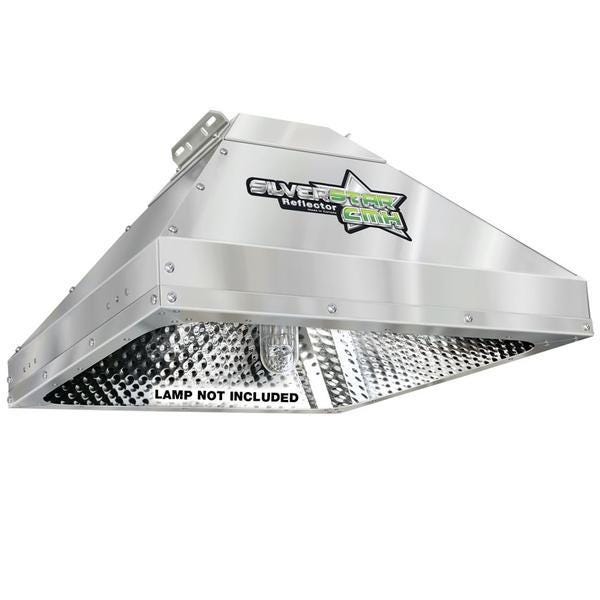
Features:
The Silverstar CMH reflector is made from highly reflective German textured aluminium for excellent light uniformity and diffusion. It has a multifaceted design that will provide superior uniformity and maximum output. The Silverstar CMH 315W has an integrated PGZX socket that is designed for use with CMH technology. Renown for its quality, Silverstar is always a sure investment. The Silverstar 315W System provides maximum lumen intensity, uniform distribution, and deep canopy penetration. The vertically installed CMH bulb (not included) provides an efficient and complete spectrum, with higher efficiency and less heat output when compared to HPS or MH lamps. Since the CMH bulb spectrum is much wider than HPS/MH, a 4200K or 3100K bulb can be used from vegetative state straight through to flowering, or alternate 4200K during vegetative and 3100K for flowering to maximize growth and yield.
A few last tips…
Get Most Reflective Hood as Possible (95% Reflectivity)
Hoods commonly come labeled as having 85% or 95% reflectivity (though some may not say anything about reflectivity, which usually means it’s 85%). Although it’s often more expensive to purchase a hood with higher reflectivity, it’s not a bad idea if you can afford it! Although there’s not a huge difference in performance between the two types, the 95% reflective hoods definitely do reflect more light. Every bit of extra light received by your plants can make a difference!
Get a reflector / hood that is labeled to have 95% reflectivity, if possible
A Good Hood Can Be Opened Up
This may be something you don’t think about the first time you’re getting a hood/reflector, but they each have different ways to get inside so you can screw in your bulb.
If possible, get a hood that’s been labeled as having either “hinges” or “sliding glass” (preferably hinged) in order to get to the light socket. Otherwise you might be sticking your hands in from the side air hole whenever you want to change the bulb. Not being able to get past the glass can also make it difficult to clean the inside of your hood if it gets dirty (and the glass should be as clean as possible to make sure it’s not blocking any light from getting through). However, although this is a matter of convenience for you, it doesn’t really have much effect on your plants.
Make sure you can somehow remove or open the glass in order to get to the inside of the air-cooled hood to change the bulb or clean the glass
Do I want a 6-inch or 8-inch opening on the sides?
Every air-cooled hood has an opening that can be used to connect the hood to a fan or ducting. These openings come in different sizes, so which do you choose? 6-inch is the most common size, and has the most options, but you may have reasons to want a bigger size.
6-inch — Effective for cooling up to three lights that are hooked together < — Most common sieze, if you’re not sure, get this!
8-inch — Necessary to get enough airflow when more than three lights are being hooked together, though you have fewer options
Make sure your hood has the right sized openings for the ducting you plan to use (if in doubt, get one with 6-inch openings)
Conclusion
Remember that it’s usually best to go with a cooled reflector when possible, especially if you’re worried about grow room temperatures rising too much.
Overall, though, once you know what you need for your grow room, making the right choice is a lot easier! When in doubt, just check out our suggestions above, and know that there’s no wrong way to go with any of the options listed in this guide.
Best Smell-Proof Containers 2022
December 15, 2021
ECO Farm 3 Speed 18 Inch Automatic Bud Leaf Trimmer Machine VS Pro-Cut P2X Leaf Trimmer
December 14, 2021
ECO Farm ECO-Panel Samsung LM301B 320W Quantum Board LED Grow Light VS PHOTOBIO X3 340W S4 Full Spectrum LED Grow Light
November 29, 2021
ECO Farm UI2 690W Samsung 301B Chips LED Grow Light VS Phantom Photobio•MX 680W 100–277V S4 Spectrum
November 27, 2021
Get on the fast-track to better growth with LED grow lights. Finely-tuned light recipes improve the quality, consistency and yield of vegetables and fruits — even during winter months. Whether you are growing vegetables indoors or growing fruits indoors, LED grow lights complement natural light, supplying the spectrum and intensity that your crops need without adding extra heat. Plus, LED lighting is an efficient way to increase lighting capacity and lower electricity usage.
What is the best colour light for plant growth?
Chlorophyll absorption, photosynthesis, and growth are aided by violet-blue light in the 400–520 nm range. Flowering and budding are stimulated by red light in the 610–720 wavelength. Photosynthesis is essential for plant growth, and grow lights should supply the right spectrum of light. Check out the offered colour spectrum before purchasing a light. For your growing environment, broad-spectrum lights are the best option. LED lights can help in this situation. The majority of LED growth lights provide both forms of colour spectrum lighting, allowing you to reap the full benefits.
You probably already know that plants require light if you know anything about them. It is used for photosynthesis, which is the conversion of light into carbohydrates. Plants turn light to food in layman’s words. They will perish if they do not receive food. But here’s the thing: here’s the thing: here’ Plants in the house, as the name implies, live in the house. Outside, where there is less light. You already know all of this. I’m just double-checking that we’re on the same page. Sure, many plants can survive in low light, but only a handful can survive in complete darkness. There aren’t any, unfortunately.
What do they mean when they talk about full-spectrum light?
“PAR” stands for photo-synthetically active radiation. This measurement of light is often referred to as full-spectrum light. Full-spectrum lights are the wavelengths of light between 440 nm and 700 nm which includes ultraviolet and infrared. These plants use this whole spectrum to photosynthesize light into simple sugars.
When purchasing a LED grow light system, you will find that the higher end systems will all be full spectrum. Be cautious when investigating cheaper grow lights as manufactures sometimes claim to be full-spectrum but don’t provide IF and IR LED Chips in their units.
Is full spectrum light absolutely a requirement? You can get away without ultraviolet and infrared but this could leave your plants open to unwanted issues such as molds and mildews. Ultraviolet light is nature’s sterilizer, it’s even used to kill viruses. When growing in a small area such as a grow tent it really is important to have ultraviolet to mitigate the risks of enclosed growing.
Full spectrum LED lights generally have two operational modes; vegetation and flowering. In Vegetation mode the grow light will use 40% less energy and use less red light. This is because vegetation doesn’t require as much energy as flowering a plant. As well flowering plants require more red light to grow fat healthy buds. When you’re ready to start flowering your plants just flip the operational mode over to flowering and you are done. No need to change light bulbs.
While LED lights emit light faster and take up less space, it requires precise power management. Find out if this is the type of lighting that’s best for you and how it compares to other grow lights.
One thing is for sure a full spectrum LED grow light will produce a larger yield than a LED grow light that isn’t full spectrum. I’ve grown with both options and the full spectrum option really takes LED grow lights to the next level.
ECO Farm UI2 690W Samsung 301B Chips LED Grow Light
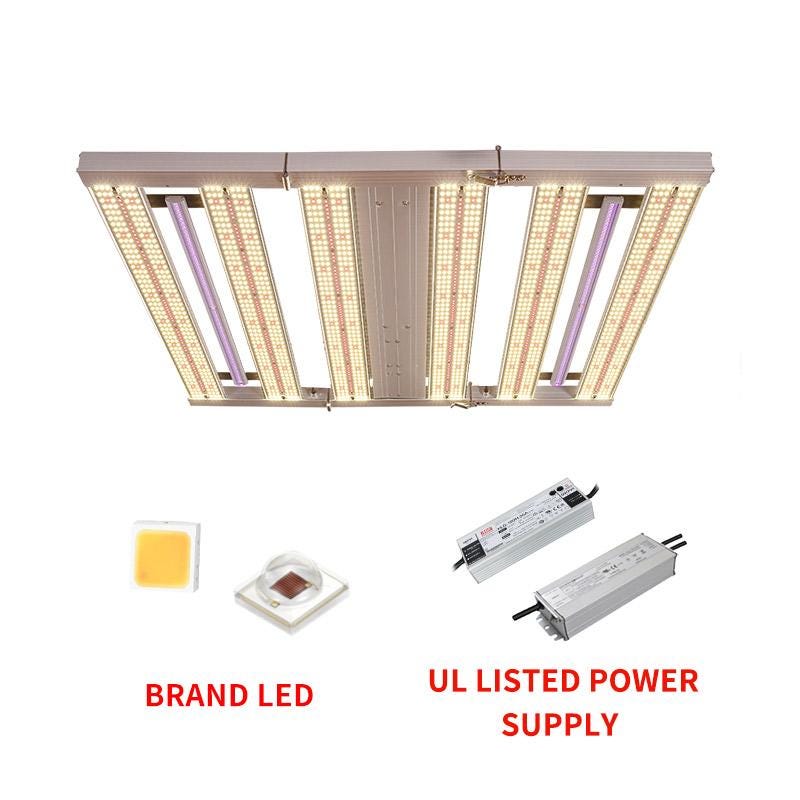
Features:
This ECO Farm LED grow light adoptes high efficiency with 2.8 umol/j while only consuming only 690watts. Adequate and sun-like light can prevent the growth of plants from spindly and moulding. The best lighting solution for indoor hydroponics and soil cultivation. More uniform coverage. Perfect for 5x5 with max of 6x6 space. If in a grow tent, over 90% of reflected light can be absorbed by plants. New designed aluminum material quickly disperses heat without a noisy fan. The light intensity can be changed by dimmer knob according to the different growth stages of plants. Saving up to 50% energy and 30% cooler than than other grow lamp. With 180°folding design, the angle and range of light can be adjusted appropriately and storage space saving. One will meet all your needs.
Phantom Photobio•MX 680W 100–277V S4 Spectrum
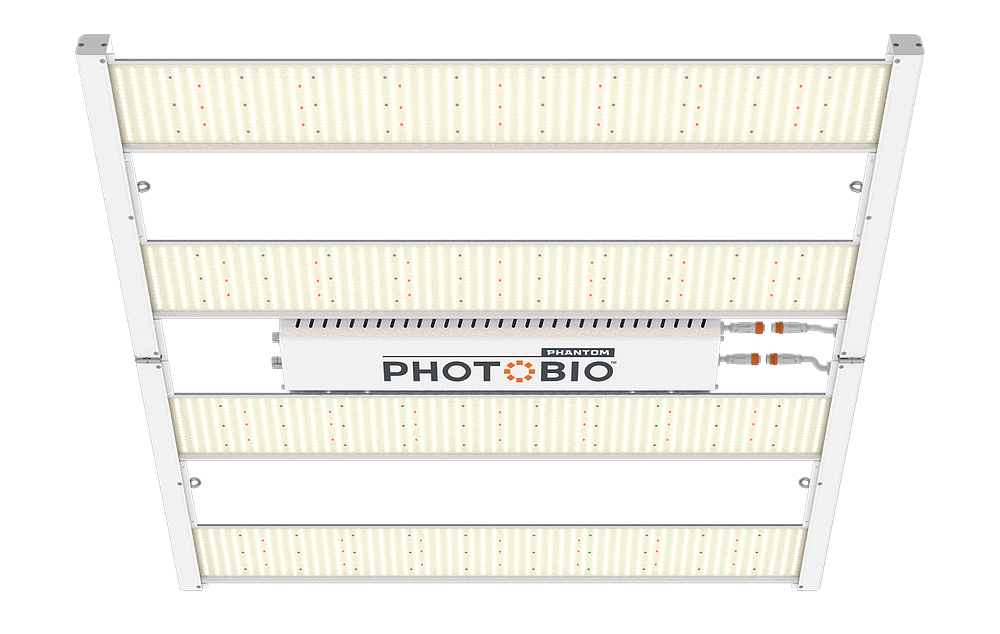
Features:
PHOTOBIO grow light abandons the bar style concept in favor of a more efficient contiguous circuit board to deliver unparalleled PPFD uniformity to the canopy. The iLOC Integrated Light Output Control onboard dimming knob allows the grower to adjust the photon output intensity to accommodate the various stages of plant growth for optimal photosynthesis activation. With the knob adjusted to 100% using 240V, the MX uses 664W and puts out 1700 μmol/s photon flux (PPF). With the knob adjusted to 40%, the MX uses 270W and puts out 40% of the high-efficiency photon flux. The high efficiency S4 spectrum does not change when using the dimmer knob and still provides ideal red to blue ratio for vigorous growth and maximized flower development.
Why UV and IR good for plant cultivation?
Full-spectrum led grow light contains not only visible light, they also have infrared (IR) light and ultraviolet (UV) light.
UV rays are not pleasing to humans as they make our skins tanned or even cause cancer. But UV rays are good for plants. They help plants to form shapes, growing beautiful colors, and improve resistance to the external environment. For those who can only grow plants in shady interior spaces, UV grow lights are needed. Besides, short UV radiation will also help prevent plants from growing stems without flowering, and even kill germs that are harmful to plants’ growth.
IR rays mostly produce heat. Plants and crops need heat to grow vibrant. And you will need an IR light as a fill light in hydroponics — growing plants without soil.
How to choose the right LED grow lights
There are many factors to consider when deciding on the right LED lights for you.
Your grow space
Your lighting needs will vary quite a lot depending on your unique physical space. Because of the way light is distributed by a particular fixture, it might make more sense to have a few small fixtures as compared to one large one. This is where the PAR chart comes in handy.
For example, if you’re lighting a 4-by-8-foot space, perhaps you’d get better overall coverage with two lights that have a single point of light emission versus one light that has multiple, spread-out diodes. You can compare the PAR charts of different lights — while also weighing optimal light coverage against your budget — to make the best choice.
The product specs
Do your homework. Comparing one product’s advertised wattage and price to another product’s wattage and price is like comparing apples to oranges. Look at metrics like PPF, the PAR chart, and photon efficacy to truly compare products.
Your budget
LED grow lamps can be quite expensive, though there is a wide range of products out there at various price points. That said, you generally get what you pay for with LEDs, so if a product is touting superior specs at a low price, be suspicious. Considering that LED fixtures should provide years of useful life, it might be worth the investment to spend a little extra. But if budget and initial investment are driving considerations for you, more traditional lighting options like compact fluorescent lights (CFL) or high-intensity discharge lights (HID) might be the better way to go.
Conclusion
Research is making strides in understanding how LEDs affect plant growth. This better understanding, one hopes, will lead to better technology that will one day help tackle our food problems.
For those of us living in apartments that don’t receive an abundance of sunlight, there are affordable and small growth chambers that should work just as well as the sun. Just make sure that the light isn’t switched on all the time, since too much light is bad for a plant!
Even with these grow lights’ options, sunlight remains the best light source for plants. So if you can, take your plants out for a day of sunbathing!
Neocision Spectra Explorer 340W LED Grow Light-BVV VS Fluence SPYDRx 340W LED Grow Light
November 23, 2021
If you have plants that need a little more fun in the sun, but you’re lacking the sunny climate or the south facing window of your dreams, you might be thinking about supplementing with grow lights.
More specifically, you’re probably wondering what kind of grow lights are the best for your indoor plants. And let’s be honest — that brings up a whole other host of questions.
While picking the right kind of grow lights for your plants might seem a little overwhelming at first, don’t panic. We’ve got the lowdown on all the basics you need to know to keep your plants happy, healthy, and photosynthesizing with the best of ‘em.
What are the Benefits of Using LED Grow Lights?
Compared to HPS grow lights, LED Grow Lights are far superior.
1) Economical: As a result of using less energy and heat to create more useable light, LED grow lights are a far more cost-effective and handy solution than traditional lights, which have long electricity bills.
2) Eco-Friendly: LED lights are environmentally safe and recyclable since they do not contain dangerous gases or compounds like mercury or lead.
3) Longer Lifespan: LED lights are more environmentally friendly since they consume less energy to create the same amount of heat. Designed to last up to 102,000 hours, they are built to last a long time. They are more long-lasting and durable than conventional lights because of their low operating temperature.
4) Efficiency: More than 40–60 % of the power generated by LED lights is used to provide useable light, compared to ordinary incandescent bulbs. Unlike traditional lights, LED grow lights emit extremely little heat and use 80% of their power to produce light instead of wasting 20%-40% of their energy.
5) Less Heat Production: Due to the lack of 730nm wavelengths in LED lights, the plants receive only a small amount of heat, and the rest comes from the panel itself. As a result, grow lights are ideal for the cultivation of plants, as they do not produce as much heat as other types of lighting.
6) Better Crop Production: By giving plants appropriate lighting in the form of grow lights, they are able to grow at a faster rate and produce more crops.
Neocision Spectra Explorer 340W LED Grow Light-BVV
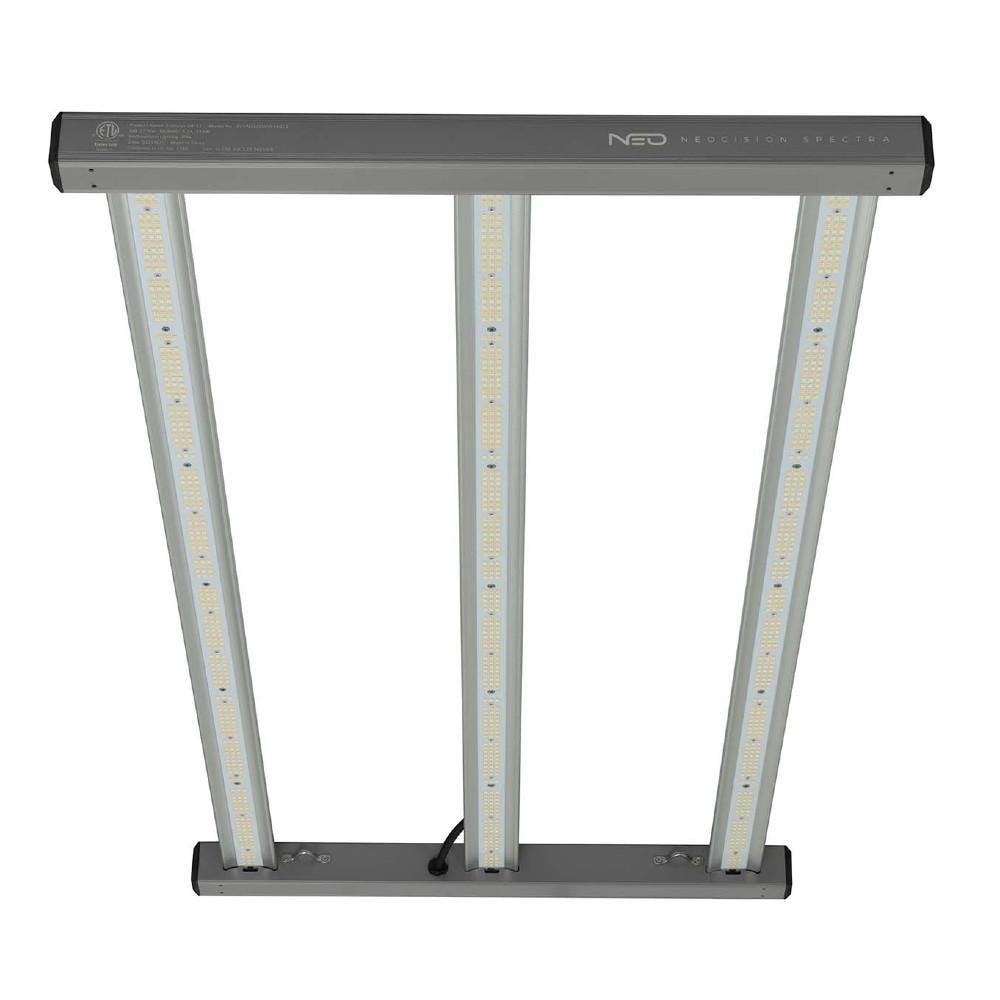
Features:
This BVV grow light is designed for a full grow cycle with maximized red for increased photosynthesis, and effectively promotes plant leaves, stem growth, and flower yield. The full spectrum, infinite close to natural sun light, is suitable for all stages of indoor growth of all plants, accelerating flowering time and increasing yield! Ideal for 2’ x 4’ tent environments for increased consistency and yield. Using the most advanced SMD LED technology, to provide high PAR output, high energy efficiency and long life while improving light transmission. Comparable to a traditional 600W HPS or CMH light. Save up to 70% on your electricity bill.
Fluence SPYDRx 340W LED Grow Light
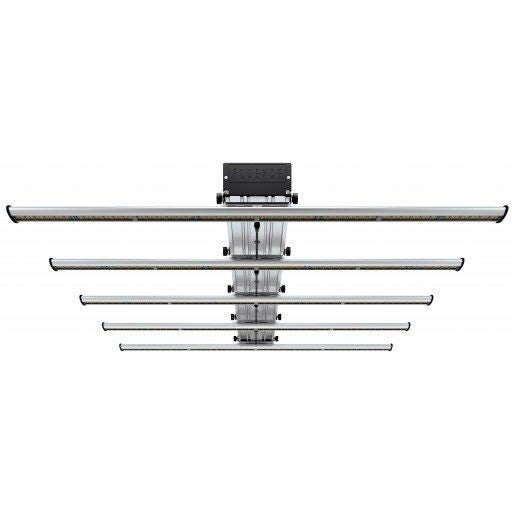
Features:
Fluence grow light is a 340W LED indoor grow light with an average — not max — PPFD above 455 is perfect as an vegetative-stage, top-lighting solution for commercial applications, and as a full-cycle top-lighting solution for residential applications without CO2 addition. Anodized, extruded aluminum alloy chassis with integrated heatsink for longevity and passive, natural convection thermal management (no fans or moving components). Fluence PhysioSpec Indoor is a full-cycle spectrum optimized for rapid growth and complete plant development. Tailored for growing plants from initiation to senescence (germination, clones/cuttings, mothers, vegetative and flowering applications) in indoor environments.
Factors to Consider Before Choosing Grow Lights for Your Plants
Seasonal changes or lack of windows can make it tricky to provide enough light to your houseplants or cultivate a wide variety of plants at any climate and during any time of the year. Grow lights are specially designed to substitute natural sunlight. They help to stimulate photosynthesis by providing the correct color spectrum needed for the plant to grow and flourish. The right light fixture or bulb enables you to savor delicious tomatoes in the dead of winter or enjoy the aesthetics of beautiful violets year-round. Different varieties of Grow lights have their strengths and characteristics. Here’s a list of factors to consider before choosing Grow Lights for your plants.
1. Color (Light Photosynthetic Spectrum)
Light spectrum measured in nanometers is helpful to know the wavelength of lights. We use different nanometres ranges for different growth phases of plants. Certain types of bulbs filter out the rays in the spectrum needed by your plants. Indoor plants need a light spectrum, ranging between 400–700 nanometres, also known as Photosynthetically Active Radiation (PAR). This rating is mentioned on the packaging of the bulbs. A 2700K bulb will be a good starting point for flowers but is not high enough for growing vegetables, which requires a 6500K bulb and is a wide-spectrum option.
2. Intensity
Plants are exposed to a certain amount of light. It depends on the kind of light, the strength of the bulb, and the position of the lights.
3. Duration
Photoperiod means the duration of time in which a plant receives enough light; day length. It is the developmental responses of plants to the relative durations of light and dark periods. Plants need 16–18 hours of exposure to external light each day to grow. More exposure doesn’t necessarily improve plant growth at any rate. Plants that indicate photoperiodism that use day length to trigger blooming should be exposed to under 12–14 hours of light in the stage of flowering. The cycle of darkness that follows should, however, be uninterrupted to form fruit and flowers well. A timer should ideally be used to control the duration.
4. Plant Kind and Growth Phase
Various kinds of plants may require different light intensities. Forest plants typically don’t need the same amount of light as tropical plants originating from a hot sunny climate need. Additionally, the amount of lights plants need are not the same at different phases of their growth. Of course, a full-spectrum grow light can aid in all stages of plant growth.
5. Placements
Correct placement of light is very vital for your indoor plants to induce photosynthesis. It is also crucial to choose the appropriate light with the best intensity and a supplemental light source to extend daylight. Additionally, full-cycle lighting in a space without any natural light should also be considered before choosing Grow Lights. Hot bulbs can burn plants and ruin the crop. In essence, plants placed far away from light absorb little heat. Typically, each square foot of the growing area of indoor plants needs 30–50 watts.
6. Cost
Small bulbs can be obtained for cheap, while large operations to set up a light source for growing plants can cost thousands of dollars.
Conclusion
Ultimately, grow lights come down to your preferences, growing space and whatever your budget allows. Just start small if you’re not sure how often and how much you’d like to grow.
I sincerely hope this guide on growing lights helps you successfully grow your veggies indoors.
And, speaking of that … It really feels empowering to be able to grow your own food. Whether you can’t find what you need in stores or you just want to be more self-sufficient, this is an excellent step in that direction!
Frigidaire White Dehumidifier VS Ivation 70 Pint Energy Star Dehumidifier
November 10, 2021
Growing plants indoors require a suitable dehumidifier to avoid moisture-related issues like root rot and mold.
Based on our research and testing we have selected the best dehumidifiers from various manufacturers for grow tents/rooms to help you choose the right one!
How does a dehumidifier work?
In simple terms, a dehumidifier sucks in air from your desired room at one end of the unit, removes the moisture from that bunch of air by using a fan to draw warm, moist air over a cold coil (in much the same way that a refrigerator works) and then blows the now cool, dry air back out into the room again, out the other end of the unit.
The moisture the dehumidifier collects usually drips into a removable collection bucket within the unit. You have to either manually remove and empty this bucket every so often, or, with some dehumidifiers, you can run a water hose out from the dehumidifier and into a floor drain. If you don’t have a floor drain, then some dehumidifiers have built-in pumps that can direct the collected moisture out and up through a water hose leading to a shop sink, out a window or wherever might be convenient.

Features:
At 745 watts, this unit uses less power than any of its peers. Granted, if you place it in a small growing space, it’s still going to add heat, but it will add less heat than just about any other comparably sized unit on the market, and it’ll cost you less to use. Those are good things, and the unit’s energy efficiency is one of the major reasons this model placed a solid second in this part of our review. Feature-wise, it’s got everything you’d expect from a dehumidifier in its class and in fact, offers the same feature set as our overall winner (auto-defrost and restart, fill sensor for the tank and auto-shutoff, two fan speeds and two modes of operation (time or humidity target). Also, it has a washable filter that traps dust, pollen, pet dander, and the like, returning air to your growing space cleaner than when it went into the unit.
Ivation 70 Pint Energy Star Dehumidifier
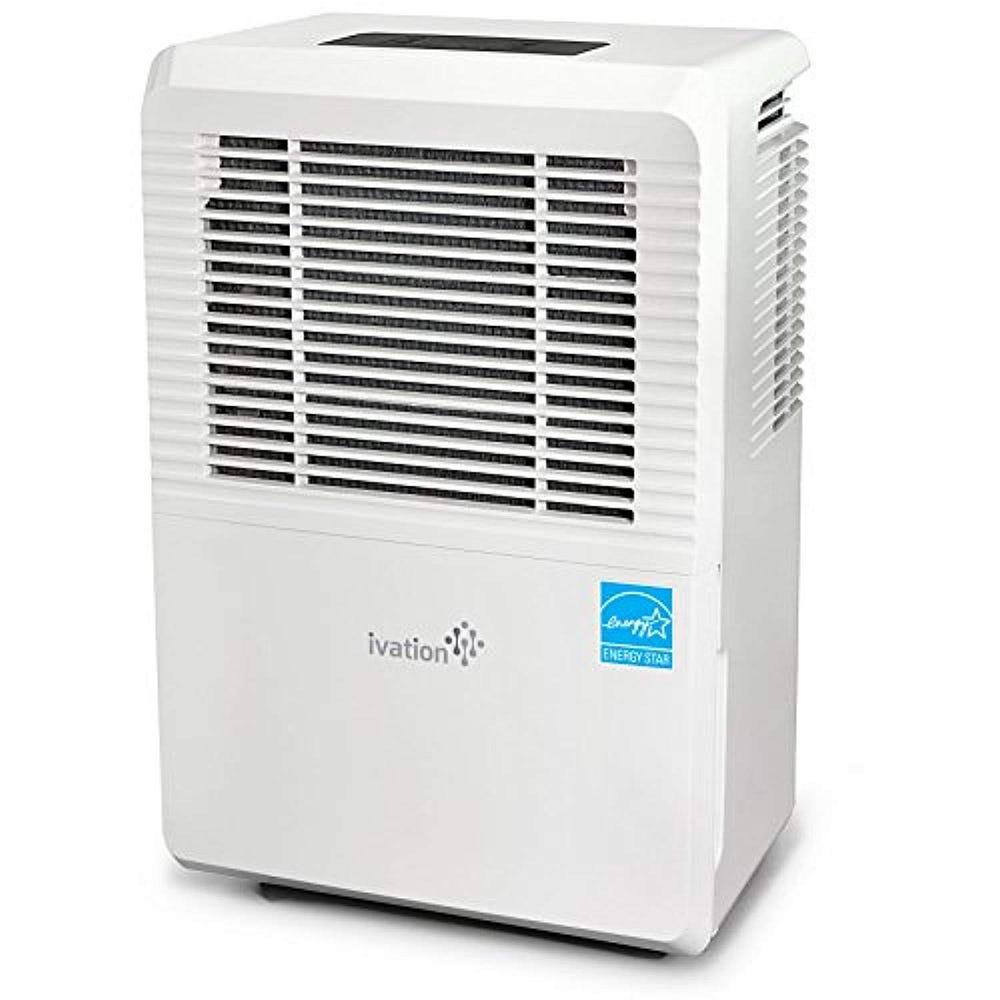
Features:
Compact But PowerfulAt just 40 pounds, it fits discreetly in most spaces. Durable smooth-rolling caster wheels ensure portable ease, and you can customize air regulation with two fan settings, for effective moisture removal in areas up to 4500 square feet.Breathable Comfort & CleanOur innovative filtration and evaporation system ensures a safe and pleasant atmosphere by preventing mold, mildew and structural cracking.Relief from the HeatRemove up to 70 pints of moisture a day for relief during humid months. Simply empty the high-capacity 1.3-gal reservoir upon auto-shutoff, check the level indicator, or hook up the optional hose for continuous draining.Tech Savvy SystemA smart Ivation design lets you control moisture levels with a simple LCD interface. Check the humidistat, set your ideal levels, adjust fan speed, program the 24-hour timer, and receive important filter and reservoir alerts for no-hassle operation.
HOW TO SELECT THE BEST HUMIDIFIER FOR GROW ROOM/TENT
Following things must be kept in mind before purchasing the dehumidifier.
✓ The weather in your area — is it humid or dry most of the time.
✓ Expected water extraction rate of dehumidifier.
✓ Size and design of dehumidifier.
✓ Functions- handles, wheels, dimensions, loudness etc.
✓Size of your grow room — most important.
✓Level of humidity in the air.
IS RUNNING A DEHUMIDIFIER FOR GROW TENT EXPENSIVE
Knowing how much it costs to run a dehumidifier is important especially when you have large grow tents to maintain. A standard model of dehumidifier runs around 280 watts per hours. Now this comes out to be 0.28 kW which will directly give you per day price if multiplied with the cost of electricity in your area.
Benefits of Using a Dehumidifier for a Grow Room
One of the most essential stuff you want to apprehend as growers of cannabis (other than such things as led grow lighting fixtures and) is that the best plant life require a consistent intake of gallons of water. When the moisture in a grow tent is excessive, over time the plants will use their leaves to absorb moisture from the distance round them. When the moister is low in a grow container, they take in water via their roots instead.
Thus, having manage of the fine moisture to your indoor grow tent lets in you the pleasant manage over your plant life’ nutrient intake. Moreover, having the proper degrees for your develop tent improves the improvement of the cannabis plant, supplying you with robust, healthy, and leafy vegetation. Outside of reaping rewards the plant life, controlling the moisture inside the grow room with one the first-class develop room dehumidifier is likewise quality for stopping troubles such as mildew, bud root, and leaf rot.
White powdery mould is one of the maximum common problems with developing cannabis in high-moister environments. This fungal sickness is hard to deal with as growing hashish flowers grow high-quality in humid environments. The true news is that a grow room dehumidifier and proper airflow for your grow tents are all you want to save you this sort of fungal growth and make a appropriate surroundings.
The worst hassle that growers experience due to terrible environmental control is bud root. The hassle with bud rot is that it’s difficult to identify. You may want to become harvesting your hashish flora thinking you’ve got the fine healthy crop simplest to discover that you without a doubt have a vain batch of moldy buds. Make sure you purchase the satisfactory dehumidifier for develop room and make sure most effective the great effects and that you don’t encounter this frustration.
What’s the Right Position to Install your Dehumidifier?
Dehumidifier placement in a grow room is critical to the effectiveness of the dehumidification process. Whether you are using a single unit for the entire room or several dehumidifiers, you need to adhere to the following tips:
Ensure Even Distribution: Balance the distance between each unit. If you’re using a single unit, you need to place it in the middle of the room.
Maximize Airflow: Place each dehumidifier in an open space where there’s plenty of air movement. Ideally, avoid corners and ensure that there are a few feet between the filter and the wall.
Point to Consider: Some dehumidifiers are free-standing while others are suspended or installed inside the wall. You may also encounter ducted units that are capable of dehumidifying rooms in which they are not installed. If you go for a ducted or suspended dehumidifier, ensure that it comes with a remote control as accessibility may not always be easy.
Conclusion
Dehumidifiers can play an integral part in any grow tent or grow room, and if your serious about controlling every aspect of your crops environment and producing the best yield possible, then investing in the best dehumidifier for grow tent is a must.
Without one, serious issues may arise that put an end to your crop before it’s even begun.
It doesn’t end there though, make sure if you do invest in a quality grow tent or grow room dehumidifier that you get your sizing, placement, and air flow correct, as these three things are just as important as the equipment itself for a successful crop.
Mars Hydro SP-250 LED Grow Light VS SunStream 250W Broad Spectrum LED Grow Light
November 02, 2021
Not getting the desired results for the indoor plants you handpicked for yourself? Are you sure they are receiving the light that they need?
After all, sufficient availability of light is as essential for plants as the soil quality. So, if you are still using an average-quality grow light, it’s high time you choose a better light source like a full spectrum LED grow light. In fact, this type of grow lights is considered to be one of the best options for indoor plants.
Benefits of using an LED Grow Light
New generation LED grow lights are designed with the latest technologies to provide essential lights to the plants.
Most manufacturers use a full spectrum to keep the balance of PAR and Lumen Output per LED.
Comes with a built-in cooling system that doesn’t let the system overheat.
LED Grow light produces less heat compared to other lights.
LED Grow lights provide more yields and are more efficient than traditional CFLs.
You don’t need any additional ballast to start the light.
LED Grow lights come with simple plug-and-play functionality. They are very easy to use and don’t come with complex functions and features.
Mars Hydro SP-250 LED Grow Light
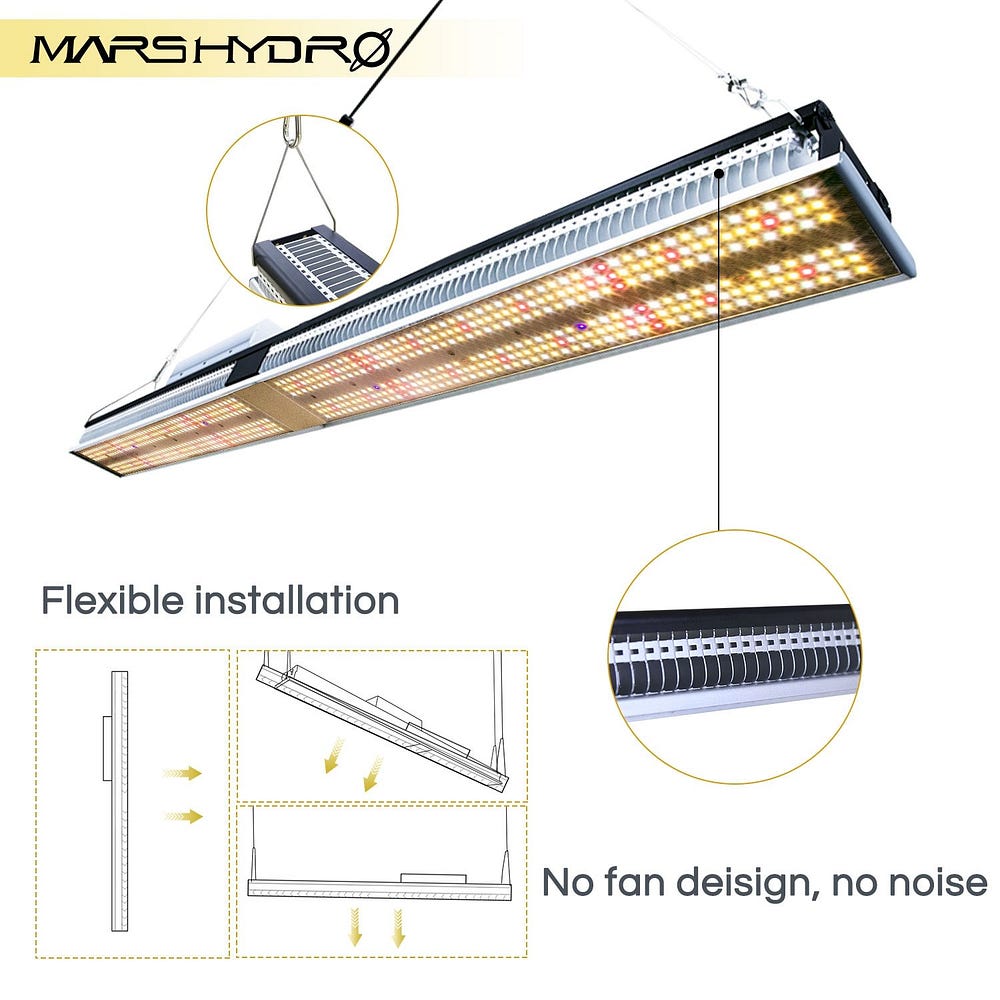
Features:
The Mars Hydro grow light is meant for a multitude of applications, from greenhouse growing to indoor cannabis gardening. Thanks to multiple features, Mars Hydro SP250 is an excellent piece of hardware for your cannabis plants. First and foremost, The SP250 pulls 230-watts from the wall and is meant to replace 2,000-watts of traditional HID lighting. For those of you who have experience with HID lighting — this is a massive difference. When all is said and done, your electricity bill will be a fraction of what you’re used to paying with traditional HID grow light systems. Thanks to the efficient diodes that the Mars Hydro SP250 utilizes, along with the IR, UV, and full-spectrum bonuses — this is a true grow light contender. The SP250 is built similarly to T5 CFL lights, which are long in shape. These units perform exceedingly well when paired with multiple units. However, the SP250 doesn’t come cheap, which may sway would-be buyers to a different design.
SunStream 250W Broad Spectrum LED Grow Light

Features:
The SunStream LED grow light is a high-power LED fixture for cultivating cannabis, flower, vegetable and fruiting crops. Ideal for commercial growers, its streamlined design fits narrower grow spaces to optimize light distribution. The SunStream 250 is proven to increase crop yield and quality, enhance crop appearance, extend crop’s shelf life and improve taste. Broad spectrum light maximizes production throughout the growth cycle supporting all stages of crop growth. Secondary optics provide even illumination and ensure uniform photon delivery. Long-lasting LED fixtures generate less heat compared to HID grow lights, so fixtures can be placed much closer to plants.
Tips for Choosing Grow Lights
When choosing grow lights look for μmol/m2/s. If your plants are grown inside until they are ready for flowering, the lights will need to be between 300- 600 μmol/m2/s.
Pay attention to the amount of blue light and red light that the grow lights emit. Remember seedlings will require more blue light. Several models of grow lights now come with a button that switches from vegetative growth to fruiting/flowering.
Another unit of measure you may see is the color temperature which is measured in Kelvins. Seedlings need at least 65000k, which is more of a cool blue light color temperature. Red light color temperatures range from 1000k- 5000k.
A lumen reading will be present on the fluorescent tube set up. Lumens measures the amount of yellow light that humans see and it not a good measure to determine lights for plants. However more lumens will generally be better.
Look for triple chip LEDs. This provides more useable light for plants and is much brighter and efficient than double and single-chip LEDs.
Look for fans or heat sinks, these keep the light kit cooler. Cooler light kits mean that they will last longer. This may also mean higher wattage, but it is important to keep the lights cool.
Look for a daisy chain option. Lights that come with a daisy chain option will allow you to attach more than one unit together allowing you to expand your system over time.
Use an auto timer set up so seedlings can receive between 12–16 hours of light.
Wattage in LED lights has nothing to do with brightness or how intense the light will be. Wattage relates to the amount of electricity used, and therefore the cost of running the lights.
Follow the manufacturer’s guidelines for how far away from the plants the light should be from the light source.
Veg and Bloom Switch options are helpful. All young seedlings including flowers will need to be on the veg switch. Two weeks prior to putting plants outside, also turn on the bloom switch.
What should be the appropriate distance between the LED grow light and the plant canopy?
Appropriate distance between LED growing light and plant canopy is not universal since there are of a different brand, coverage area, beam angle, light shape amongst others. It is recommended to follow the manufacturer’s instructions. Nevertheless, 18″-36″ is a classic distance; 18″ for flower and 24″ or more for veg.
What is a number of watts needed per square foot of growing space?
About 32 watts of actual wattage is needed per square foot of grow space. Though some LED grows lights require less. On the contrary, some others require more depending on productivity. It is recommended to adhere to the manufacturer’s instructions since all LED units are differently designed.
Conclusion
If you are asking the big question, “what kind of light is best for plants growth?” then these choices are the best that you can choose from. Along with the buying guide that we’ve constructed above, you now have a clear-cut guide on how to choose the best light for vegetative growth that you can have for your garden.
Do you think that this guide was able to help you? If you did, share it with your friends! They’ll most likely also benefit from it.
HLG 550 V2 BSpec Veg Quantum Board LED Panel VS Carambola 4000 Full Spectrum LED Grow Light
October 29, 2021
There is no substitute for natural light. However, when it comes to growing cannabis, the farmers still will not deny that the gentle warmth of sunlight needed for their plant’s growth is not always available. That is why there have been innovations, inventions, and discoveries to turn unfavourable conditions into favourable ones.
To achieve optimal light for plants, the best option is LED grow lights. These are the most effective source of providing adequate light for growing indoor plants. They improve the deficiency of the sunlight, which passes through windows and on the plants.
The salient features of LED grow lights are adequate energy production, less energy consumption, and the spread of full-spectrum color light. They do not only provide light and energy to the plants, but they also provide ambience. It is pertinent to clarify that they are entirely different from other High-Pressure Sodium lights, commonly known as HPS or CFLs, which are compact fluorescent lamps.
LED grow lights are so common that almost everybody who has even a little know-how and experience about farming is well acquainted with their nature, function, and availability. Above all, they are the most effective artificial substitute for sunlight.
What Size LED Grow Light Do I Need?
The most important bit of equipment in your grow room is your light.
Why? Light is your plant’s food, you need to feed your plants high-quality food for them to produce high-quality yields.
LED lights for weed are now considered the best lighting option by most growers due to their energy efficiency, durability, and full spectrum.
However, with all the options and technical jargon, finding the right light for your project can feel a little overwhelming.
To work out what size of LED grow light you need, you first need to calculate the exact size of your grow space.
The Size Of Your Grow Space
When growing cannabis, a good rule of thumb is to use a minimum of 50 watts of light per square foot of growing space.
We want to flood our plants with light ( food ) so that they have lots of energy to produce big potent buds.
Therefore, we need to calculate the square footage ( length x width ) of our growing space.
We’ll then multiply this number by 50w to give us the rough wattage of light we require.
EXAMPLE: I have a growing space that is 2ft long and 3ft wide. This gives me a square foot grow space of 6 ( 2ft x 3ft ). I would then multiply this number by 50w, which gives me 300w. Therefore, in this example, I would require an LED grow light that was at least 300w.
HLG 550 V2 BSpec Veg Quantum Board LED Panel
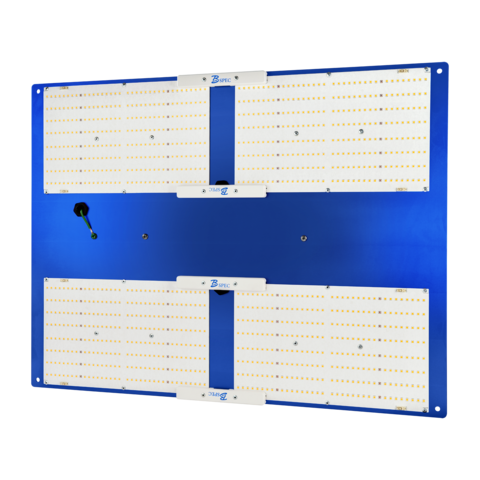
Features:
The HLG LED grow light is designed to replace a single-ended 1000watt HID. Each HLG-550 V2 uses 4 of our custom designed full-spectrum high efficiency white light quantum boards with Samsung LM301B and Blue 470nm. This unit is dimmable, with wattage output from 200 to 480 watts. The light has 4 circuit boards, each containing 288 (1,152 total) Samsung LM301B diodes. Samsung is known to produce top-shelf LED quality, so you won’t have to worry if you decide to go with this quantum board grow light. The boards are placed on a larger aluminum panel with a dimmable Meanwell driver on the opposite side. If you’re curious, or just switching over from an HPS grow light, the HLG 550 V2 is roughly equal to a 1000 watt HPS grow light.
Carambola 4000 Full Spectrum LED Grow Light
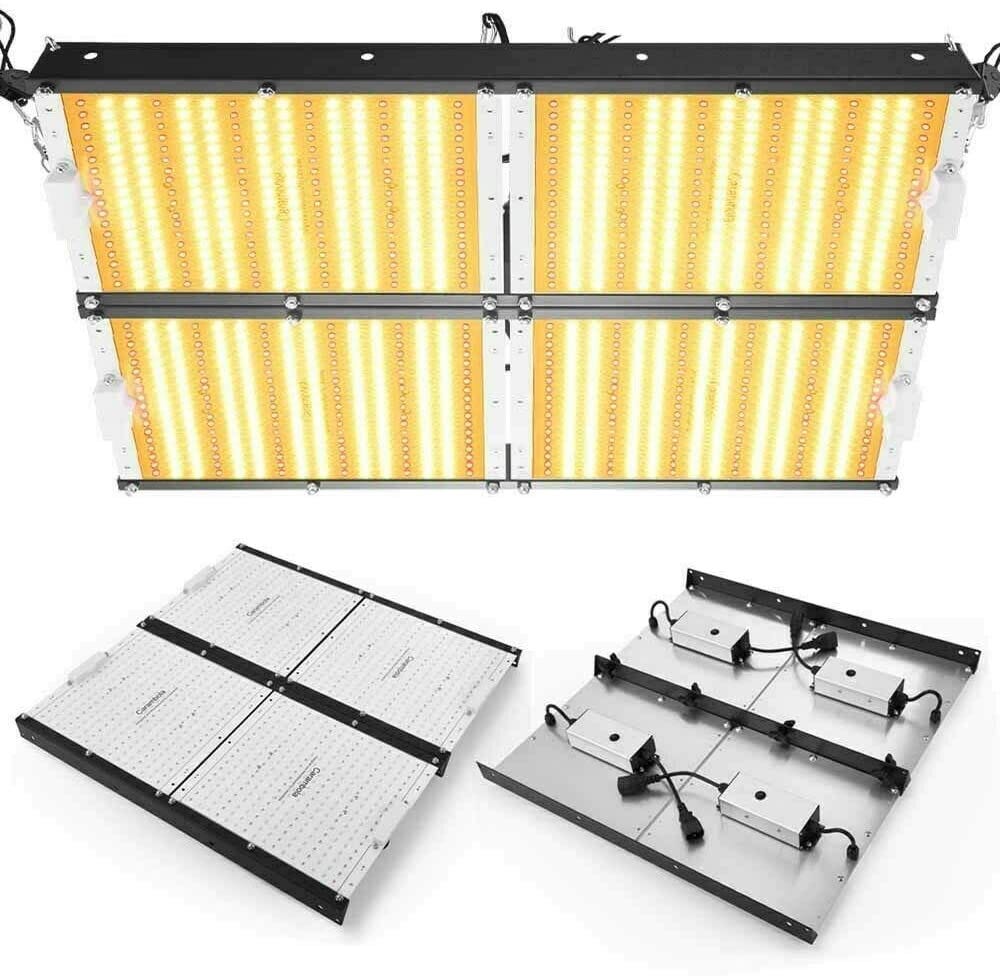
Features:
This Carambola LED grow light has a sunlike full spectrum 3500K 5000K and IR 660nm 760nm RED, Infinite close to natural sun light, suit for all plants whole stages indoor growing, rapid plant response from seed to flower.With bloom booster mode greatly increase the red spectrum to get a better yield.Advanded CHMHPS spectrum indoor lighting system will be your best choice.This grow light consumes only 480 Watts true output with 1152 PCS LEDs, more scientifically and energy-efficient! Perfect for 5' x 5' veg stage at 25 inch above the canopy, 4' x 4' bloom stage at 20 inch above the canopy. Newest SMD LED technology provide excellent PPF: 1100 μmol/s, designed to replace a single-ended 1000watt HPS; Carambola CBG4000 Plants Growing lamp makes you get 40% higher yield compare OLD blurple led lights.
What to look for when buying LED grow lights
Below we have rounded up what to look for when shopping for LED grow lights, followed by a list of the best LED grow lights available on the market today.
The type of light you use has a monumental effect on your cannabis growing efforts. Many factors go into what LED light to use for growing cannabis. We did the research for you and have rounded up the most important ones below.
Light spectrum
While plants can grow under most spectrums, to make the process efficient they need specific wavelengths throughout each growth stage. High quality LED lights provide the full spectrum of light, allowing you to select the best one for each growing stage. Plants naturally react and grow based on the spectrum of light they get outdoors. They will grow as long as they receive blue and red lights, though most good LED lights offer the full spectrum. The spectrum you use in different stages will affect the plant’s growing patterns.
Blue lights (400nm — 500nm): Blue lights are often used in the vegetative stage of growth. That’s because this spectrum mimics the sunlight during summertime. Plants use this blue spectrum as a hint to spread its leaves in order to soak up as much sun as possible during the summer. It’s recommended to use blue light during the plant’s vegetative stage so it spreads and grows leafy. However, if you use blue light throughout growing you’ll get plants with short stems but with large healthy leaves.
Red lights (660nm — 730nm): Red or yellow lights are often used in the flowering stage of growth. This spectrum mimics the sunlight during the fall. This is when plants grow tall to prepare for the upcoming winter. Taller plants are in a better position to bud and pollinate via winter winds. Using more red light stimulates your cannabis to grow taller and flower (promoting bud growth).
Since you’re playing the role of the sun, you can choose the optimal spectrum of light for the strain of weed you’re growing. Most LED grow lights come with customized spectrums of light that are optimized for speedy growth. Manufacturers often state the great PAR of their LED grow lights. Photosynthetically active radiation, or PAR, is the wavelengths of light between 400nm and 700nm. These wavelengths are the best for photosynthesis.
Amount of light
The lighter your plants receive, the better they grow. So, how do you find an LED grow light that emits the highest quantity of light? For one, LED lights are already designed to directly aim at the plant. Panels that are 3W per bulb produce the highest yield without burning the plant. More panels help spread light over more areas. It’s recommended to use an LED grow light with over 2 panels if you plan on having a large growing space.
Wattage per square foot and coverage area
Your grow lights will be running for long hours, so you’ll want to save electricity. You’ll want to check the electrical output of your light, which should optimally stay over 300W. If the wattage is too high, you can run the risk of burning your plants. The recommended amount for growing cannabis is 50–60 watts per square foot. You will also want to know how much area your lights can cover. Most lights we recommended today have a coverage area of 3 ft x 3 ft at the vegetative stage.
Low heat emission
It’s important to find an LED grow light with low heat emission. You don’t want to run the risk of burning or discolouring your plants. You can put lights with low emission close to your plants, allowing them to receive more direct light. Controlling the temperature of your grow room is important for saving electricity and room temperatures contribute heavily to plant growth. If the air is humid, similar to the tropics, your plants grow optimally. Grow lights that emit too much heat turn the air dry, meaning your plants won’t grow.
Quality of materials
LED lights can be an expensive investment and the quality of your light source highly affects the yield. You want an LED light that gives off 3W per bulb, meaning the semiconductor chip needs to be of high quality. You need to look for durability; very durable LED grow lights last for 50,000 hours plus. Look for manufacturers that state longer warranties (2 years plus). They are most likely using the highest quality materials. Most grow lights we suggested today come with a hanging hook and power cord.
Conclusion
Choosing the right product isn’t easy and for many of them, it could be a time-consuming task. However, with this guide, my aim is to help you guys find the perfect led grow lights for your needs.
I hope that you’re able to find the right led grow lights for your usage. If you are still struggling to find one, feel free to comment below or contact me.
DL Wholesale 16'' Open Top Hand Trimmer VS TrimPro Unplugged
October 28, 2021
When you only need to trim a few plants and have time on your side, handheld bud trimmers are ideal. A bud trimmer allows much more control than the hand-cranked bowl trimmers for bud or the more expensive fully automatic bud trimming machines.
When time is not on your side, an electric marijuana trimmer or hand crank bud trimmer is faster for trimming buds, but it may compromise quality buds in the end due to a lack of control that a handheld bud trimmer offers.
It’s really simple to choose the best bud trimmers that can get the job done and cultivating perfect buds for consumption.
You should be able to comfortably use the Trimmer.
It shouldn’t be too expensive, but it shouldn’t be cheaply made, either.
The plant remains intact and juicy after trimming. Trims the leaves of the buds accurately.
Why Trim Cannabis?
When cannabis plants grow, trimming is essential. Trimming cannabis will make the product more aesthetically pleasing, but there’s more to it. By bucking the cannabis plant bud and removing leaves, you’ll make parts of the nug with more trichomes more accessible. Additionally, by removing fan and sugar leaves, you’re getting rid of the parts that would cause harsh smoke. The foliage doesn’t wick away moisture too well. Furthermore, trimming cannabis is essential to the curing process. Curing–or slowly removing moisture from the bud–plays a part in enhancing the smoking experience. Lastly, trimmed bud tends to produce a stronger marijuana aroma, which may influence a purchase.
When is a Good Time to Trim Cannabis?
When it comes to trimming cannabis plants, you can either do it before or after drying. Growers use both methods, so there isn’t a right or wrong way. Cultivation specialists who prefer a wet trim are dealing with high humidity, are concerned about mold, and want the cannabis bud to dry at a quicker rate. Those who use a dry trim are dealing with low humidity, want the bud to dry slower, and are looking for the bud to be denser or tighter. So it depends on the grower’s preferences. As a cannabis trimmer, your job is to be comfortable with both wet and dry trims.
DL Wholesale 16'’ Open Top Hand Trimmer
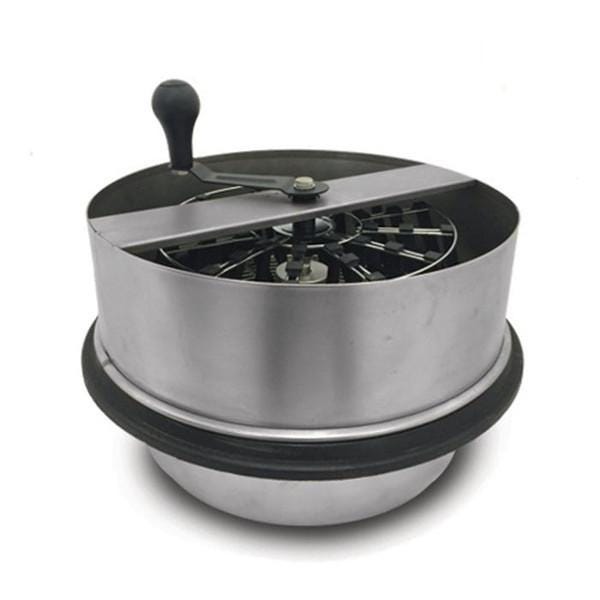
Features:
Our metal top trimmers are 100% stainless steel. There is no plastic which makes them extremely durable. Available in a closed and open top version. The open top allows you to easily see your work and also fill it without having to remove the top. It uses slim leather fingers, which gently moves flowers across the grade which houses the razor-sharp stainless steel blades, which trim the buds. You control the speed by how hard you crank, but it doesn’t take very much! Some growers prefer less agitation of their flower. We know hand trimming is hated by many. The Trimpro Unplugged makes it much easier and less painful, though. It features the most ideal ergonomics possible, with the perfect size, weight, shape, and mechanics.
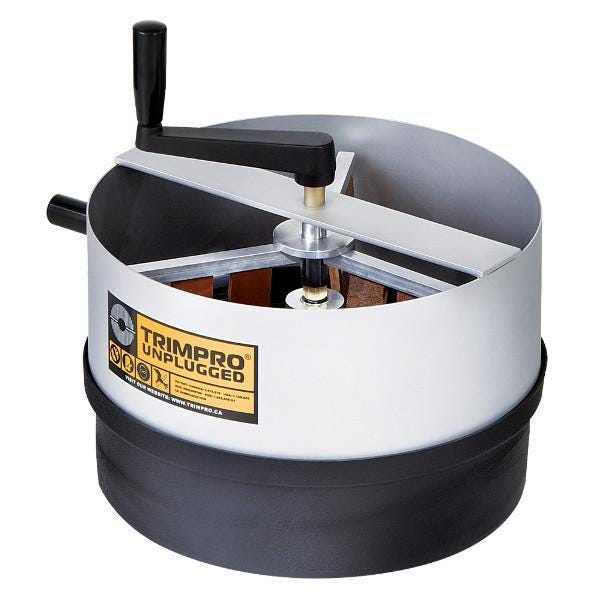
Features:
This TrimPro trimmer makes it easy to crank out harvests efficiently, whether you are a hobby grower with 1–2 plants or 10! Unlike machine trimmers, it produces no noise, keeping your operation discreet while producing a quality end product. It gives you more control over the degree of trim, while saving your hands from painful cramps and blisters. It’s easy to use, maintain, and is a great addition to any grow room. The Trimpro unplugged is completely manual, as the name suggests. This means taking the trimmer to the field is easier than ever, with no concern for finding an outlet or bringing extension cords. It was designed to get you tight trim with minimal effort and flower agitation.
Wet Trimming vs Dry Trimming
Once you’ve done with harvesting, start the most critical phase that adds value to your harvested buds. Generally, value addition matters on the types of trimming., i.e., Dry trimming or wet trimming, and the procedure used while trimming Marijuana buds. Usually, a hand trim is a common practice if you’re growing one or two Marijuana Plants. A bowl trimmer is another option if you exceed the said number that could save your time that you spend with an individual bud.
The is no comparison of a bowl trimmer vs hand trim plants as it entirely your choice depending on the number of Marijuana Plants that you’re growing. Later in the article, we would like to add a bowl trimmer review along with hand trimmers and automatic trimmers. Either it is dry trimming or wet trimming, the purpose is improving the look of Marijuana buds, enhance smoking taste, increase potency, and avoid mold deposition if you’re growing in high humidity areas. Usually, the growers follow two methods to trim Marijuana buds by hand: dry and wet. An alternative is to use a machine or an automatic trimmer. The growers could prefer any prescribed method. But, they all could finish with what exactly they want.
Wet Trimming
Wet trimming involves separating sugar leaves from the flowers after they’ve harvested, immediately. The flowers still contain a lot of moisture, and their cutting with a scissor is easier. You could pick each branch and cut sugary leaves using a curved scissor. This trimming could result in pretty decent shaped buds that could be dried later by hanging them for 2–3 days.
Dry Trimming
The branches from the Marijuana plant are harvesting first, dried for 3–4 days, and sugar leaves cut from the Marijuana flower. Dry trimming is a bit difficult and trickiest assignment if you want to trim them with a scissor. However, bowl trimmers and electric trimmers are there to ease you out for the processing of dry Marijuana flowers.
Fan Leaves vs Sugar Leaves
When you harvest your cannabis, you’re going to encounter two kinds of leaves that you need to trim off.
Sugar leaves are the leaves that grow directly on the bud. They have a harsher flavor when smoked but may be used for edibles due to their decent levels of terpenes and cannabinoids.
Fan Leaves are the first to develop in the growth cycle and are used as indicators for plant health. They contain very few cannabinoids, but not enough to give you that high.
Some people use fan leaves for salads and may also be used for salves with their anti-inflammatory properties.
Getting Started with Trimming
Before you even start cutting away, you need the right tools to get the best results.
Having the right tools will help you do your trims efficiently while maintaining the quality of your buds.
Here’s what you need:
Pruning shears for trimming the sugar leaves.
Large pruning shears or any durable scissors for cutting the branches.
Disposable Gloves, such as surgical gloves
3 Trays to segregate the trims
For trimming the sugar leaves, you may also use automatic scissors, if your resources permit. You need to have a separate set of shears for trimming the buds and taking off the branches for your plant. Some branches are quite hard to cut and the shears may get damaged or destroyed in the process.
The gloves are needed to keep your hands off the resin and avoid contaminating your buds.
Your setup for trimming should also be easy to clean. That means, avoiding carpets which can be a problem when sugar leaves fall off during trimming. Trichomes are hard to clean on such surfaces.
Keep in mind that the scent of cannabis will stick to your room, especially when trimming fresh. You may want to have good ventilation or an exhaust fan to drive out the odor unless you want your place to smell like a cannabis farm.
Before you start the actual trimming, make sure to wash your hands and put on your gloves. If you can’t use gloves, be prepared to with a lot of rubbing alcohol to rid your hands of the resin from trimming.
When taking off branches for trimming, always start from the top of the plant. The upper portion of the plant is more likely to mature first due to its exposure to the sun or your grow lights.
The lower portions might not be ready yet, thus benefitting from the additional day of exposure once the top is clear.
Now only take what you can handle. Especially when you’re set to trim a lot of buds. Taking more than what you can handle might compromise your buds.
When you’re taking out a branch, hold it at the base and cut it off. Then transfer them to your tray.
At this point, the actual trimming begins.
Trimming the Buds
Begin trimming by clearing out the fan leaves. You can dispose of them, or you may turn them into edibles later, depending on your preference.
If you plan to use them later on, separate them from your tray for sugar leaves, as mixing them will only add to plant matter that needs processing.
When it comes to trimming the sugar leaves, you don’t need to take out the whole leaf, since it goes deep inside the buds. Trying to dig in and take it out may cause damage to the buds.
Just trim off the sugar leaves to the best that you can, while avoiding damaging the buds. Go over each bud, giving it a clean look. Then put the trimmed buds on the designated tray.
In case you accidentally damaged a bud while trimming, don’t throw it away. Just add it to your sugar leaves for processing.
Once you are done trimming your buds, you can begin drying and curing them if you trimmed wet or set them aside for extraction later if you trimmed dry.
Now it’s time for clean-up.
One thing you will notice when you are done is that your scissor and gloves will be full of hash. Don’t throw that away yet. Scrape and store them in silicon canisters for use later.
You can use your sugar leaves and fan leaves for concentrates and edibles, respectively.
For the branches and the remainder of the plant that you just harvested, cut them up and put in a double bag these plant materials for disposal later. Make sure that they are rendered to an unusable state. Then take them out for disposal on the day that your trash is picked up.
Conclusion
The concept of implementing the right cannabis bud trimmer for you no longer has to be a scary thought that keeps you up at night. Industry-born trimming technology has caught up with what cultivators demand and it’s time to take a serious look at options for your business.
Our advice? Find out who top industry professionals are turning to for their operations, then try out multiple brands and see which is the right fit for your business.
ECO Farm ECOT 120W Dimmable Samsung LM301H Quantum board LED Grow Light VS GROPLANNER 150W LED Grow Light
October 27, 2021
As indoor farming gains popularity, artificial lights get better at replicating the sun. These fixtures are referred to as grow lights.
We all know plants use sunlight to grow. That’s one reason we usually grow plants outside. Now, we have plenty of choices for growing plants without any sunlight indoors. Choosing to grow lights might be overwhelming, but it doesn’t have to be. This article will show you some best LED grow lights and what the best LED grow lights feature. Hope it can help you.
Advantages of Using LEDs for Grow Lights as Opposed to MH Grow Lights or HPS Grow Lights
Using LED lights to grow cannabis, whether it is one or two plants or a huge industrial grow, offers the cultivator many advantages. Let’s explore.
The cost of running LED lights is about one third that of running traditional metal halide and high-pressure sodium lights.
Of course, less cost means less electrical usage which is better for the environment overall.
Today, most LED lights for growing cannabis canned be dimmed in order to produce just the amount of light you need while using even less power. So you can save even more. HPS/MH lamps use the full light intensity all the time,
LED grow lights are incredibly environmentally friendly. An LED light uses no mercury, no lead, no gas or filament, and no fragile glass bulb.
LED grow lights run substantially cooler than traditional lights. This is better for your plants but also better for you as cooling your grow tents becomes less of a worry if any worry at all (depending on ambient temperatures where you live). HPS/MH bulbs also need additional fans for cooling which adds to the electrical costs of growing indoor cannabis. How much cooler is LED grow lights? LED lights for growing marijuana usually run around 100 degrees F.; HPS/MH lights run between 200–300 degrees F. depending on the bulb.
Because LED grow lights run cooler than conventional grow lights, they are likewise safer to use from a fire prevention perspective.
LED lights for growing cannabis have the ability to match the light to the needs of plants. Likewise, cannabis growers should buy lights designed specifically for that purpose. Most of today's LED grow lights are “full-spectrum” and have numerous diodes of different colour temperatures that attempt to mimic the sun. So, the need for different lights for veg or flower is no longer necessary for the home grower.
LED grow lights have a much longer life span compared to HPS lights which might last for a year or so if you’re lucky. LED grow lights, on the other hand, can last up to 8 or more.
LED lights for growing are smaller in size and can help you get by with less overall grow space as they can be set closer to the plants.•It wasn’t always the case, but recent tests have shown that LED grow lights produce better crops in terms of plants getting bigger and growing faster, compared to the HPS lights.
When you get into more advanced growing, know that LED grow lights can be designed to create specific plant goals such as flowering inhibition or enhanced rooting.
Because less heat is emitted and because UV light can be added to LED lights for growing, there is less chance for bacteria and mold to form on your plants. Likewise, the need for pesticides can be reduced or eliminated.
ECO Farm ECOT 120W Dimmable Samsung LM301H Quantum board LED Grow Light
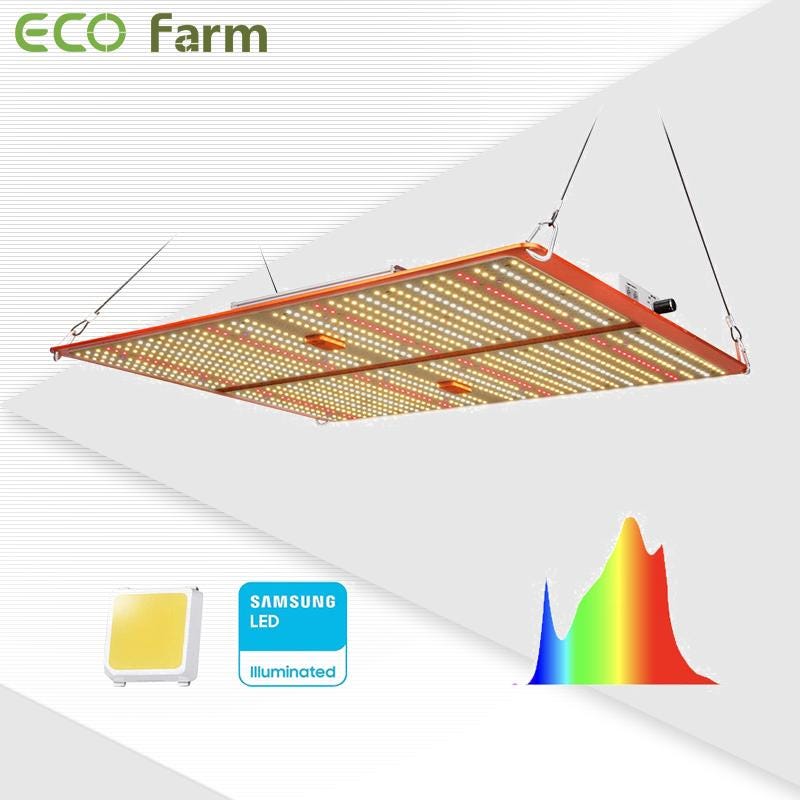
Features:
This ECO Farm LED grow light is easy to install, and is equipped with Samsung LM301H diodes, high Energy Efficiency with 2.8 umol/J, make you get 30% higher yield compare OLD blurple led lights, excellent full spectrum- white, blue, red and IR (3000K, 5000K, 660nm and IR 760nm & 395nm UV),which provides desired needs for plants seedling to harvest growth with full spectrum led grow lights and provides better light-spectrum coverage maximum PAR output at various distances. Plant grow Lights dimmable control function is more suitable for indoor plants seeding veg and bloom. The dimmer knob to adjust according to the needs of the plants ,in order to obtain perfect growth performance,which enhance high yields to obtain the ideal harvest. This growth lamp used reliable driver and high effective aluminum heat sink to ensure heat dissipation and 100000hrs lifespan.Perfect Coverage in bloom 2x2ft ,perfect coverage in veg 3.5x3.5ft.
GROPLANNER 150W LED Grow Light

Features:
Actual power draw 150W with 756pcs LEDs. The LEDs quantity of Groplanner LED grow light is twice as many as other brands with same power. High PPE up to 2.75 umol/J. You can get a high yield of 2.7g/watt. ( Standard 2.7 lbs by Groplanner 450 Watts ). This grow light makes you get 30% higher yield compared with other normal products. The full spectrum optimized and complete plant development for all growth stages from seed to flower. White 3000K and Blue 5000K promote the vegetative growth of your plants. Added Plant Red 660nm LEDs and 760nm IR could speed up the flowering and fruiting stage and promote plants to produce higher yields. Groplanner LED grow lights provides Intelligent and convenient control with WiFi capability. Switch, timing and dimming function could be easily implemented by “Tuya Smart” app.
How To Choose the Best Grow Lights
1. Plant Type
Some plants need more sunlight, some less. Some can handle brighter light, while others need a dimmer setting. To make sure your plant is thriving, pay attention to its needs and how it changes over time.
Since lots of natural light isn’t something everyone has access to in their home — and even if you do it still might not be enough for some plants, figuring out which grow light to get is important.
Knowing what to look for in a grow light, whether it’s LED lights, fluorescent, or HID — will help you make a better decision.
2. Light Quality
When it comes to planting growth, light is what they need in order to survive and spread their roots. However, the type of light given off by grow lights can vary. Some LED grow lights produce a wider spectrum of colors than other types, allowing for more healthy and rapid growth.
Some fluorescent and HID lights only emit specific wavelengths of color, which might not be enough for certain plants. For example, some plants can only grow in full-spectrum white or diurnal lighting. Others don’t really like it if it’s too bright and prefer a dimmer setting. For specific plants, it’s important to know exactly which type of lighting they need in order to thrive. If you don’t want to try out a ton of different kinds of lights and waste a lot of money on failed trial and error, choose a light that emits an adequate amount of color needed by the plant.
Whichever type of light you decide on, make sure it’s of high quality. The way to determine this is by considering the amount of lumen or PAR watts. Lumen measures how much visible light gets emitted, while PAR (photosynthetically active radiation) determines the exact color and spectrum that’s given off and this is what plants need to grow healthy and strong.
3. Light Intensity
Light intensity is the rate at which photons are being produced by a grow light source. To be more specific, this means how many micromoles per second are being emitted from the source to the plant. When determining the intensity of a light source, this should be taken into consideration as well.
The amount of lumen or PAR watts emitted from a grow light determines how much photosynthesis will occur for the plant and how healthy it will be. However, photosynthesis also depends on other factors such as temperature, quality of water, nutrient availability, and the plants’ genetics. Different plants might need specific lighting for optimal color spectrum growth. The most important part is to consider these factors when choosing a grow light type.
For instance, some LED grow lights are very intense and might not be the best option for certain types of plants. On the other hand, HID grow lights can emit an adequate amount of lumen or PAR watts but might create too much heat for some plant types.
4. Heat And Cooling
One thing to consider is how much heat will be produced by a light you choose and how this will affect your plant. A high-intensity light source might produce too much heat for some plants, especially if they are very small or just seedlings.
This is why it’s important to consider the right intensity required by a plant so it won’t be negatively affected. Some lights tend to produce less heat because they are built with cooling systems that dissipate heat faster and emit less of it overall.
This feature is often found in LED lighting which makes them a top choice for those who have smaller indoor spaces to work with. For larger indoor areas, it’s best to choose HID or fluorescent lighting because they emit more lumen and PAR watts than LED lights do.
5. Lifespan And Durability
Another consideration is the lifespan of an indoor plant-grow light source.
In most cases, LED grow lights have a longer lifespan than HID or fluorescent lights do. In general, lights that are more durable are engineered with high-quality materials made to withstand a lot of wear and tear. They are usually encased in a sturdy metal or plastic case that can take a long time to break down.
In contrast, some lights use glass bulbs which tend to eventually break after repeated exposure to heat, humidity, and frequent on/off cycles. Fluorescent lights are also known for needing constant maintenance because they require regular bulb changes every six months.
With all of these things taken into consideration, choosing a type of grow light that suits your indoor plant is easier than ever. Make sure to read up on the specific plant type that you have, and how it needs to be cared for. Once you figure that out, you’ll know exactly what to look for in a grow light in order to create an oasis for your home.
Tips of using LED grow light
Plants don’t need light 24 hours a day; they need darkness, too. Different plants have different light requirements, but if in doubt, 16 hours on and 8 hours off produces a reasonable day/night cycle.
If you’re switching from older HID or incandescent grow lights, you’ll find your plants require significantly less water since LED lights run cool and don’t dry out the soil so much. Be careful not to overwater your plants.
If your LED lights only point in one direction, you may benefit from a reflector to help disperse the light more evenly, particularly in larger growing areas.
Some budget LED grow lights might look like a bargain, but if they aren’t very durable, they’ll break quicker, and cost you more money in the long run.
You can purchase LED grow lights that come with built-in timers, which is handy if you might not be home at the right time every day to switch your lights on or off.
Some high-end LED grow lights subtly change the spectrum of light produced throughout the day to replicate the way real daylight changes from sunrise to sunset.
Look for LED grow lights that come with fixtures or hanging hooks for easy positioning.
Conclusion
It’s not difficult to set up an indoor grow area, even if you don’t have a lot of space. Using a LED grow light will give your plants the best opportunity to flourish.
VIVOSUN VS2000 Samsung LM301H Full Spectrum LED Grow Light VS EnFun Updated FS-2000 Full Spectrum LED Grow Light
October 26, 2021
Are you looking to bring a little sunshine indoors?
Maybe it’s time to start your flower and vegetable seedlings.
Perhaps your houseplants are drooping during the short days of winter or sulking in a new home.
Or maybe you simply want to enjoy the taste of your own fresh herbs year-round.
Whatever your need, grow lights can instantly provide hours of mock sunshine that your plants need for vigorous, healthy development.
They can provide any color spectrum required for every stage of growth and are easy to set up. The lamps run cool to the touch, are low wattage, energy-efficient, and have long lives.
This also makes them economical. And by starting your own seedlings, you’ll quickly recover the cost with fewer trips to your local nursery!
But they do come in a huge array of shapes, sizes, and configurations.
To simplify matters, we looked for units from reliable brands that are well-designed, easy to set up and use and provide effective coverage.
Here’s our take on the best grow lights for indoor plants and seedlings.
What exactly is full-spectrum LED grow light and why is it important?
First, you must understand the light spectrum or color wavelengths. It is the range of light colors we see or didn’t see. Visible light that our eyes can see is between 380–740 nanometers. And similarly, the leaves of plants also enjoy these visible wavelengths; the chlorophyll uses these lights to manufacture food. The green light is an exception. Because chlorophyll only reflects green and they don’t absorb it, that explains why plants’ leaves are green.
So for the most part, plants respond to the blue and red colors very well. These are the two most important wavelengths that plants need during their growth. Basically, plants need blue light for their vegetative phase and red light for the flowering period.
Understanding that many grow light manufacturers have made it possible to produce the light colors plants need with their LEDs light. Many modern LED grow lights have a programmable setting to produce different color wavelengths. By this, you can control the type of lights at the different ratios for plants at different stages of growth in their life.
These types of LED lights with a very wide or full range of color wavelengths are called full-spectrum LED grow lights.
So two of the most important criteria that affect plant growth are light intensity (or the power of light output), and light colors (color wavelengths).
For light intensity, you can opt for the powerful light, but for light colors, you should choose one with a wide range of color wavelengths (or full-spectrum).
That’s why within the scope of this article, I’ll go into detail about all full-spectrum LED grow lights on the market, and help you pick the right one.
VIVOSUN VS2000 Samsung LM301H Full Spectrum LED Grow Light
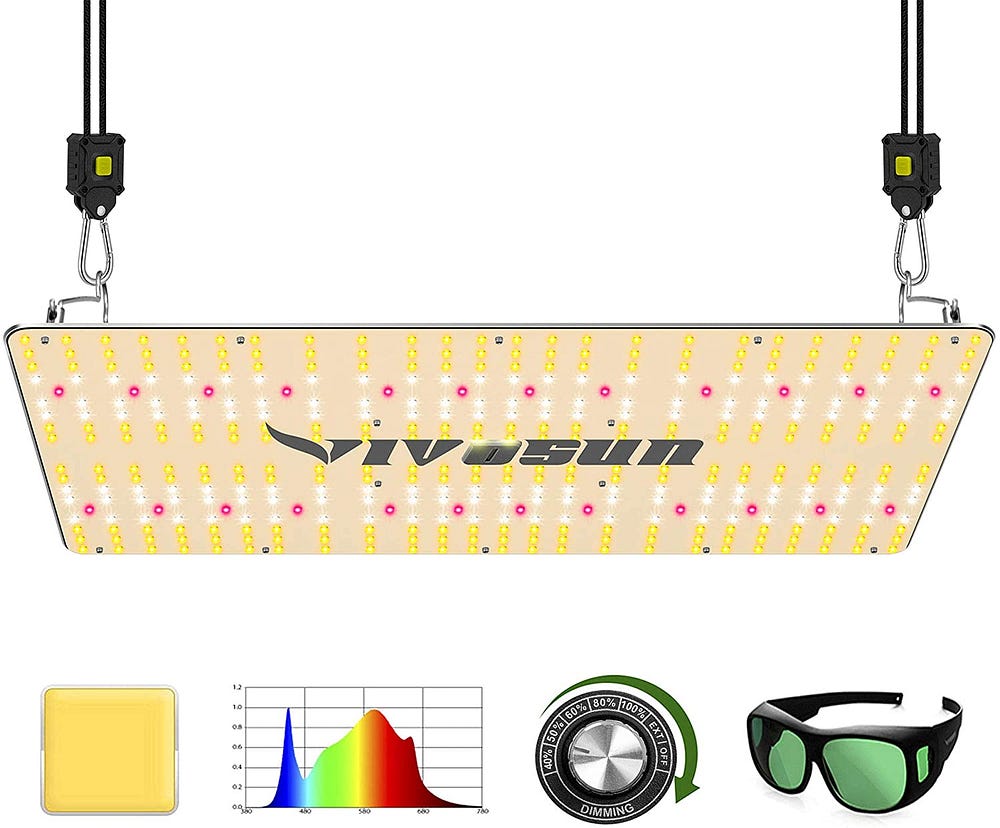
Features:
VIVOSUN LED grow lights use the latest LED plant light technology including Samsung LM301H Diodes, high-energy efficiency with 2.9 umol/J; Extremely high output but consumes only 200W of electricity, making it more efficient than traditional HID lamps and other plant lamps on the market. This LED grow light has a dimming knob that makes it adaptable to different growing periods of your plant by adjusting its output from 40% to 100%; It is super convenient for both beginners and professional growers. These VS2000 full-spectrum LEDs deliver optimal full-spectrum coverage — offering power needed by your plants at all growth stages and maximum PAR output at various distances, supporting photosynthesis of your plants in an efficient way. The VS2000 LED has a unique appearance, with power supply and ventilation holes; No fans needed means low noise; Ambient heat around this light is very low, so there is no need to worry about burns or damage to your plant; It produces mild heat so you can place the lamp directly above your plants
EnFun Updated FS-2000 Full Spectrum LED Grow Light
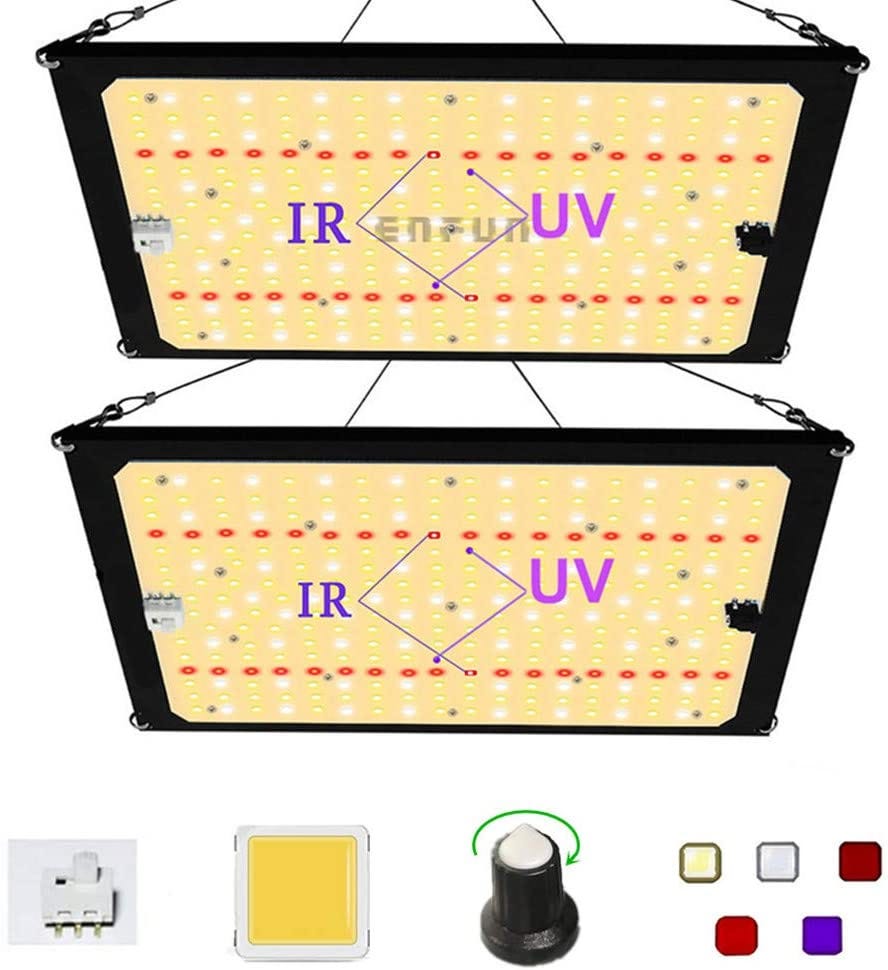
Features:
Enfun grow light uses Independent detachable Driver Adjustable,only consume 200w-240w(Driver supports tuning to 240W).High Energy Efficiency with 2.7 umol/j,create the better canopy light penetration,running 50% less power than the HPS or Blurple lamps, and still was 50% more harvest.Led grow lights for indoor plants has Customized Dimming Design. Growing lights for indoor plants full spectrum uses Epistar NEW LEDS Chips which proved to be MORE BRIGHT as other chip,and the same PPF,high quality.Excellent Full Spectrum(3000K,5000K,660nm,IR 750nm,400nm)totally 576pcs LEDs.Grow light add a red light on off,Red light is turned off when growing and turned on when flowering to promote flowering and growth. Full spectrum led grow light No Fan Noise Free design will make your growing life easy and quiet,large areas of solid aluminium quickly heat dispersing reducing light lost to aisles and walls, increase the light intensity.
Buying Guide
Light Spectrum
The plants you grow and the spectrum need at various sages should dictate the grow light’s type to buy. Generally, the combination of good quality blue and red spectra is sufficient for most greenery plants. If you plant vegetables, ensure your light has yellow, orange, and green ranges. Therefore choosing multi-spectral LEDs are the best or choose full light spectrum grower lights with proper VEG/BLOOM settings. Light spectra are crucial to plants, just like a balanced diet is to a human being.
Intensity of Light
Both location and luminaire of light determine light intensity. The plant types and habitat requirements define the light you should install in your tent. The closer the light source is to the plants, the more intensity. Therefore you should buy a system that will generate sufficient light intensity according to your plant’s needs for light. Practically, the plant top should be at least 10cm from the light board; otherwise, the light may burn the plant. So when shopping for the best led grow light for a 4X4 grow tent, make sure it will give your plants sufficient allowance to grow.
Ease of Installation
Do not go for grow lights that need masters in rocket science to install as that will attract more cost from the handyman. Just look for easy-to-install lights that you can even install yourself using the manufacturer’s guidelines.
Heat Generated
Depending on the type of plants you want to grow, some require both light and heat. The good news is that some available grower light offers light spectra and a certain level of heat. If you plan to grow such plants in your 4X4 grow tent, it would be wise to invest in LED bulbs that offer light and some degree of heat.
Lifespan and Energy Saving Ability
Generally, LED light bulbs or boards are relatively expensive than other standard bulbs and can last up to 5 times longer. The good thing is that they are more long-lasting and can offer quality service in the long run. LED light bulbs can withstand on and off switching without blowing, which is why other bulbs do not last as their filaments burn easily. These lights lamps use electric current to light and hence are the most energy-efficient you can ever have. Led bulbs are, therefore, better, unlike incandescent bulbs, which use heat to light.
Price
Although a high price is mostly directly proportional to the product’s quality, it defeats logic when you cannot afford it; when buying led light to support your plants’ growth, make sure you obtain the ideal LED light in terms of quality your budget.
Conclusion
LED grow lights need to be used properly to get the results, but if you know what to expect they pay you back with built-in cooling that allows a grower to hang their lights directly over their plants without worrying about fans, ducting or ballasts. They are easy on the electricity bill and don’t cause a lot of heat problems.
Additionally, buds grown under LEDs are known for producing colourful, sticky, strong and smelly buds! And isn’t producing quality buds the reason we do it all?
